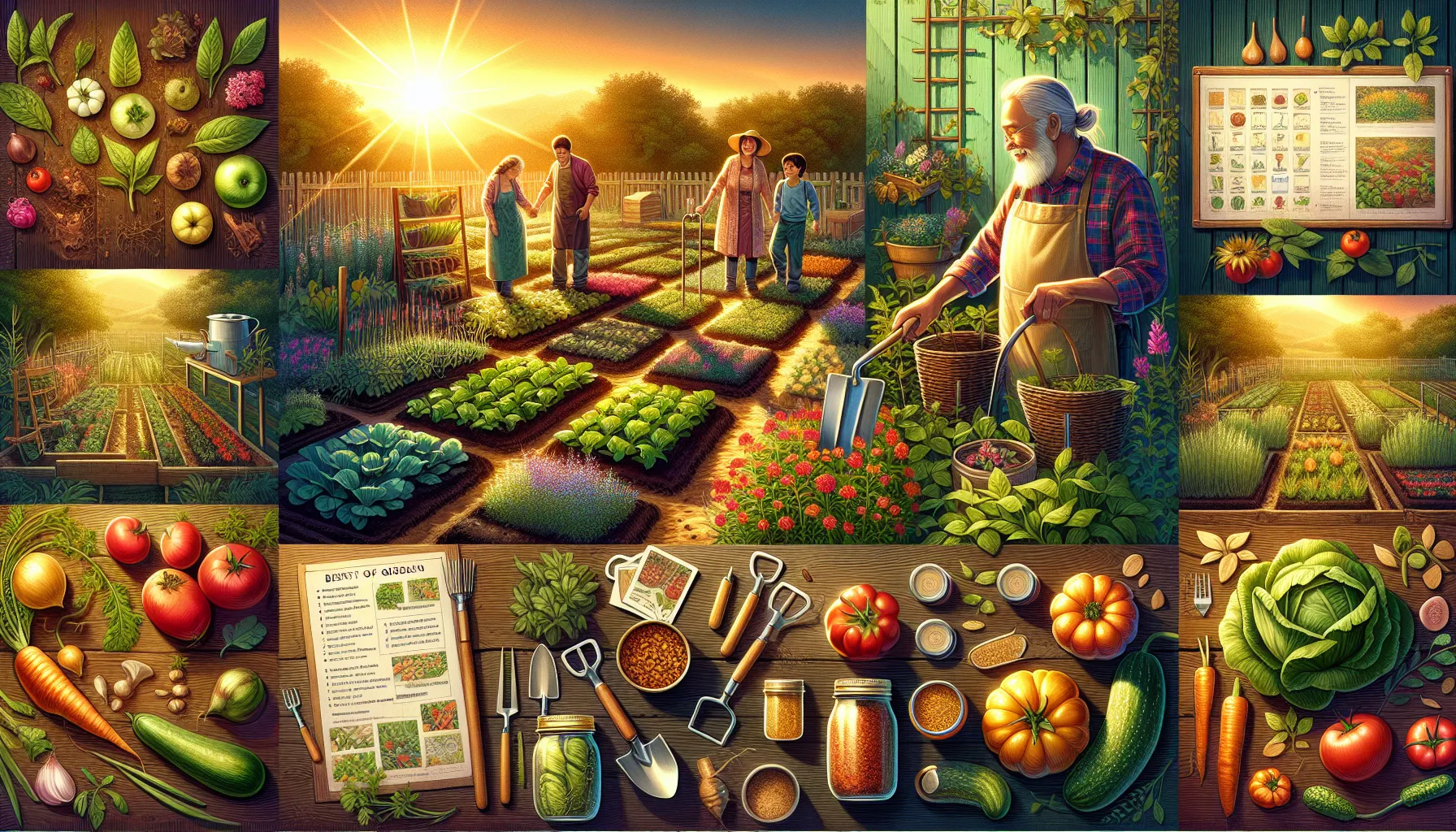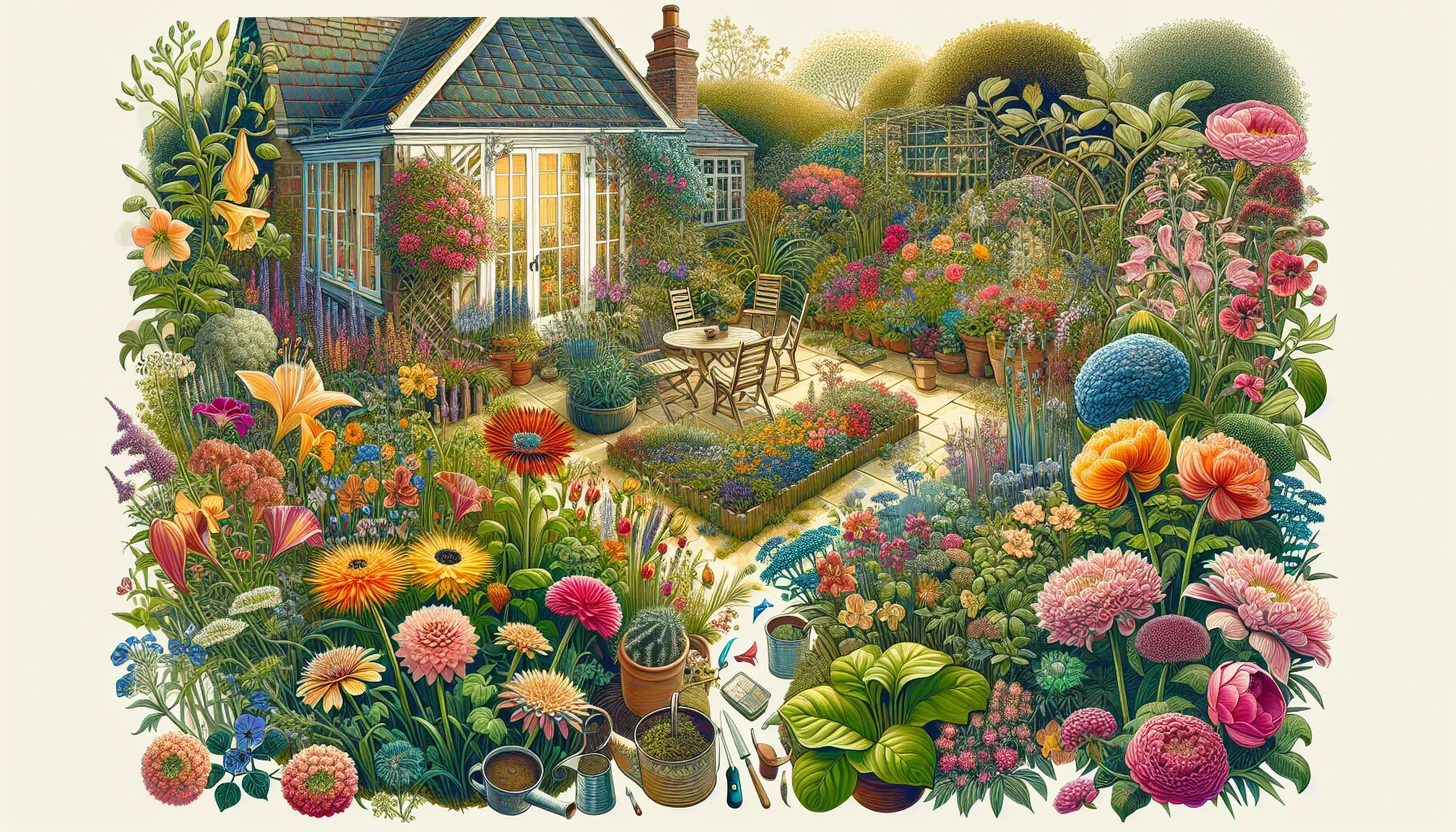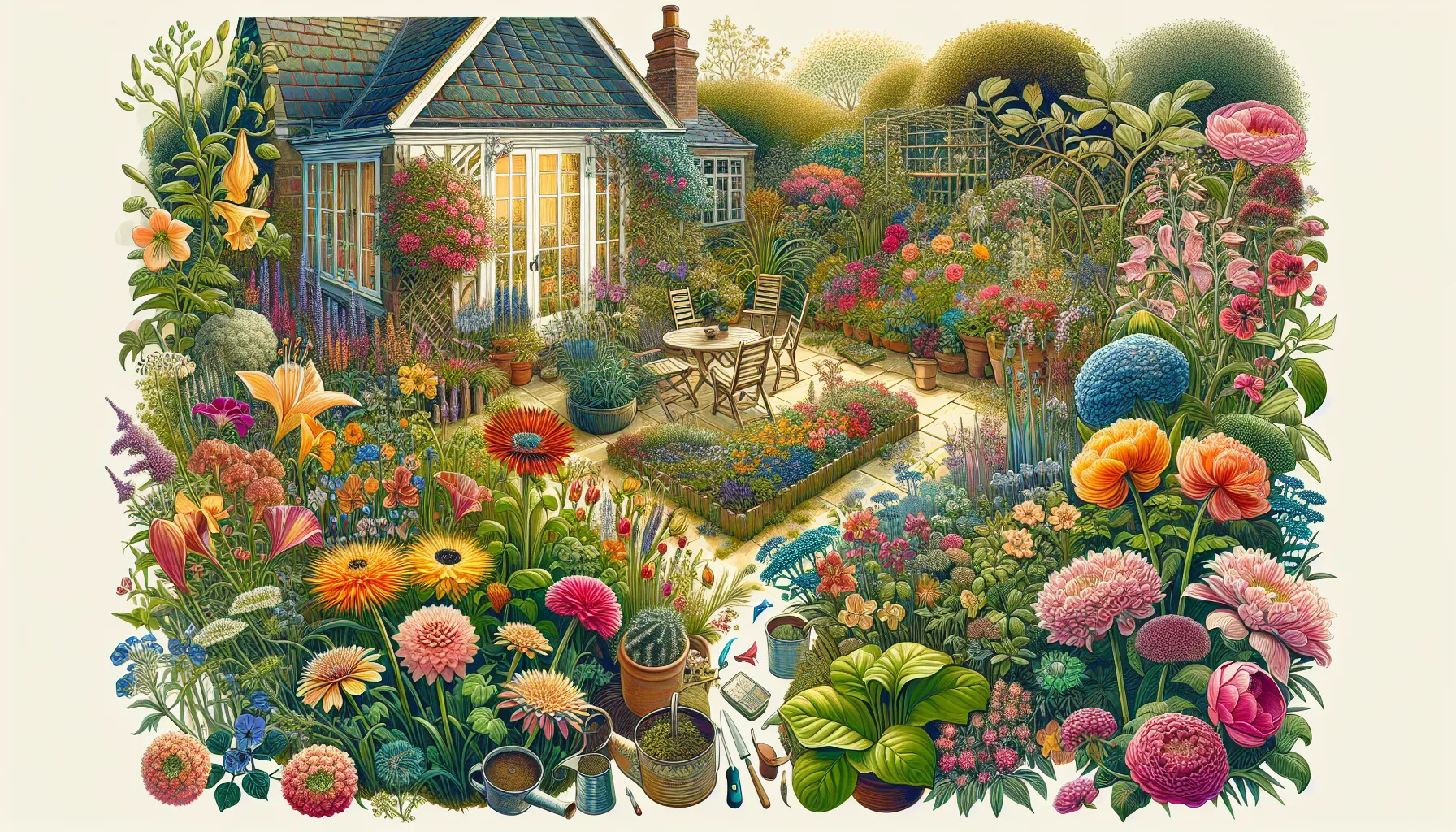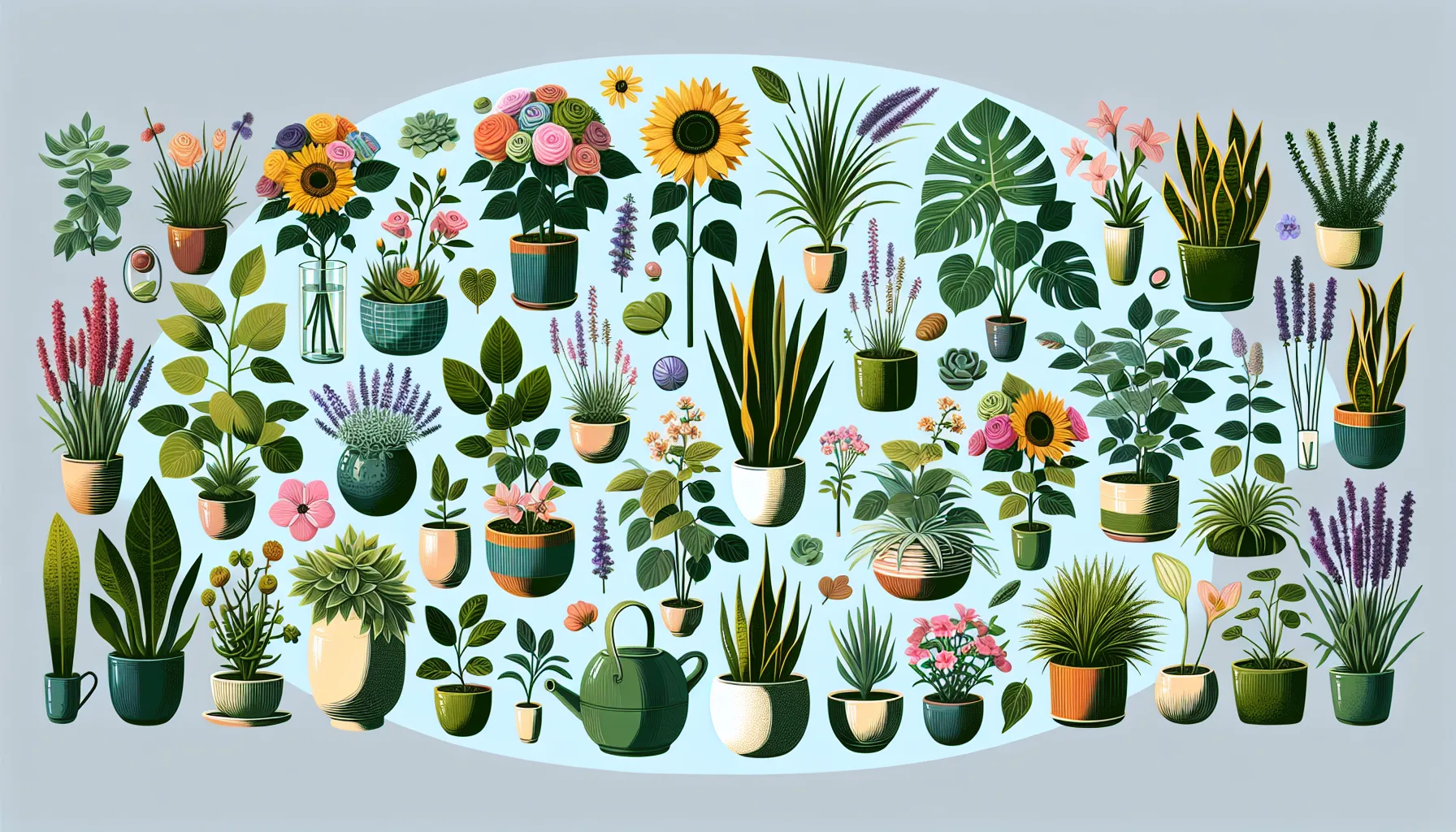
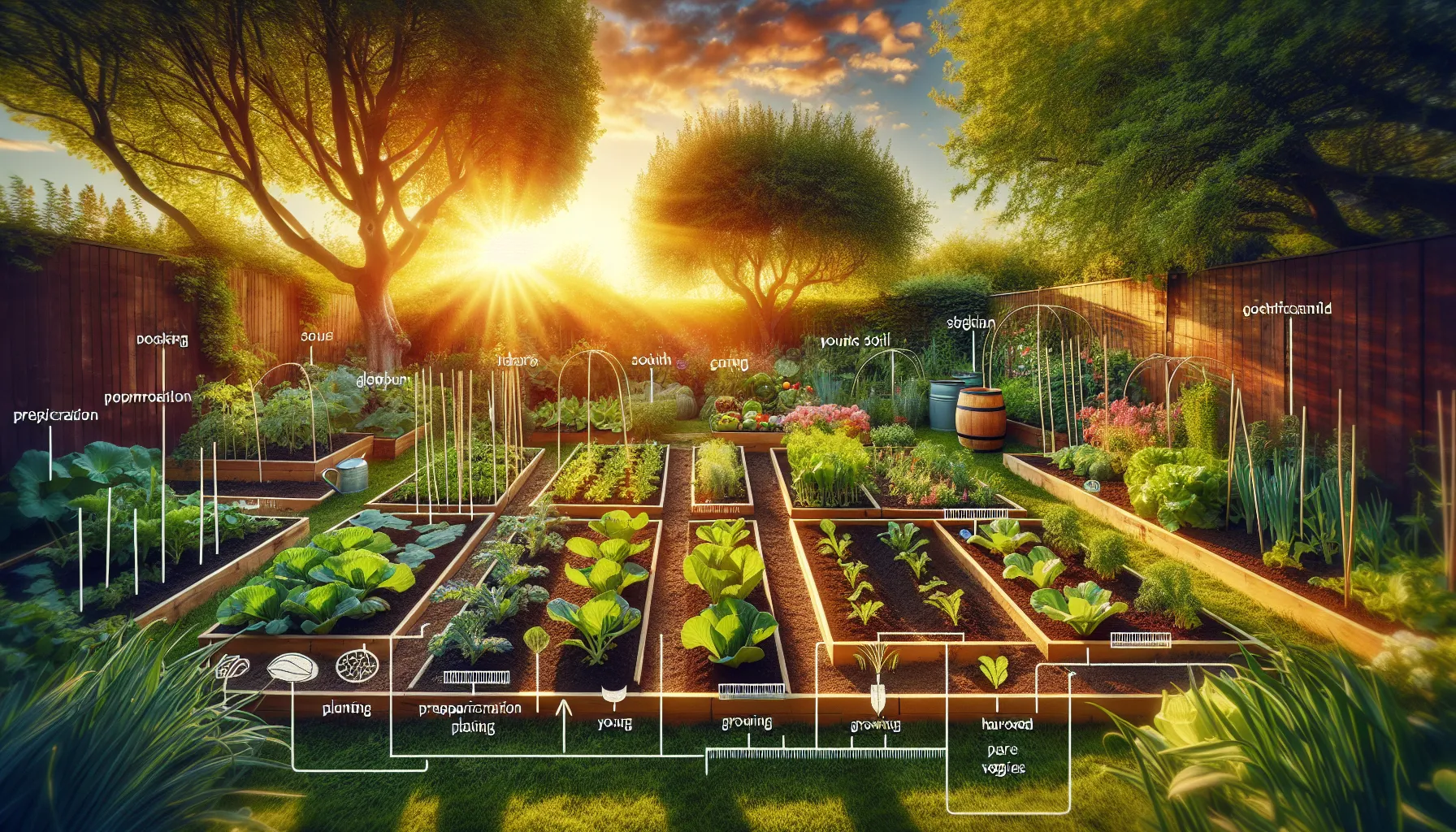
Exploring the journey of starting a vegetable garden, this post walks readers through selecting an ideal location, planning layouts, soil preparation, and vegetable choice, onto planting, maintenance, and harvesting, concluding with seasonal care tips to ensure a thriving garden that offers health, environmental, and financial benefits. Practical advice on each step emphasizes easy starts, organic practices, and the personal satisfaction derived from nurturing a garden to fruition.
Have you ever thought about starting your own vegetable garden? It’s a fantastic idea! Not only does it help you eat healthier, but it’s also good for the environment and can save you money. Imagine cooking meals with vegetables you grew yourself—it’s super satisfying! In this post, we’re going to show you how to start your own vegetable garden and keep it growing strong. Whether you have a big yard or just a small space on your balcony, you can grow your own veggies. Let’s dig in and get our hands dirty!
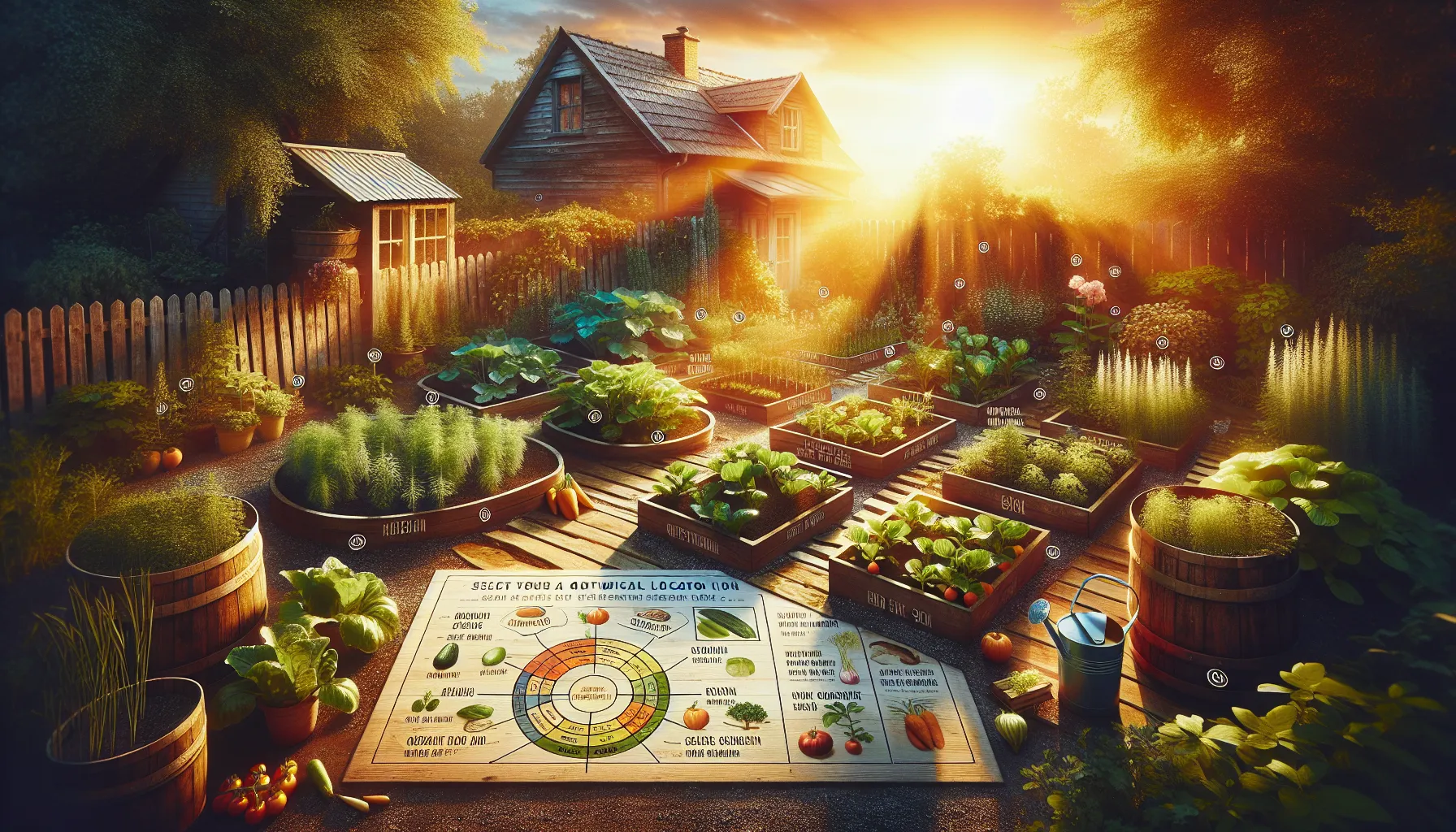
When starting a vegetable garden, where you put it is super important. Plants love the sun because it helps them grow big and strong. Try to pick a spot that gets plenty of sunlight, about 6 to 8 hours a day. Soil is another big deal. It’s where your veggies will get their food from, so you want it to be really good. You can check if the soil is ready by seeing if it’s soft and not too sandy or full of clay. Lastly, your garden needs to be near a water source. Vegetables need a lot of water, especially when it’s hot. So, having a hose or watering can nearby will make watering them much easier.
Finding the perfect spot for your garden can be like a mini-adventure. First, watch how the sunlight moves around your yard during the day. Look for a place that gets a lot of sunlight and isn’t hidden by shadows. Next, think about how water flows in your yard when it rains. You don’t want your garden to be in a spot that could get flooded. If you’re planning to use a community space, talk to people already gardening there. They can share tips on the best spots. And remember, the best spot is one that makes it easy for you to take care of your garden every day.
When you decide to start a vegetable garden, figuring out how to lay it out is one of the first big steps. There are a few different ways you can do it, and each has its own benefits. Let’s break down these options so you can pick the best one for your garden.
First off, let’s talk about the different ways you can set up your vegetable garden. Raised beds are a popular choice because they can help with drainage and prevent weeds from sneaking into your veggies. They’re also a bit easier on your back since you don’t have to bend down as far. Container gardens are great if you don’t have a lot of space. You can use pots or even recycled materials like big food containers. Finally, in-ground beds are the traditional way to garden directly in the earth. This option might require a bit more work to get the soil ready, but it can be really rewarding.
Picking the right size for your garden really depends on two things: how much space you have and how much food you want to grow. If you’ve got a big backyard, you might opt for a larger in-ground bed. But if you’re working with a small balcony, a container garden could be perfect. Think about how many veggies your family eats and try to match your garden’s size to your needs. Remember, it’s better to start small and expand later than to bite off more than you can chew!
Last but not least, companion planting and crop rotation are two secrets to a successful vegetable garden. Companion planting means putting plants next to each other that help each other grow. For example, tomatoes love being near basil, and carrots get along great with onions. This can help fight off pests and diseases naturally. Crop rotation means you shouldn’t plant the same vegetable in the same spot year after year. Changing things up helps keep the soil healthy and prevents problems. Both of these tricks can make a big difference in your garden’s success!
Before you start planting your veggies, you need to make sure your soil is ready. Think of soil like a cozy bed for your plants. It needs to be just right for them to grow healthy and strong. Let’s look at how to get your soil in tip-top shape for your vegetable garden.
The first step is to find out what your soil is like. Soil pH is a big deal because it affects how well plants can take in nutrients. Imagine trying to drink a thick milkshake through a tiny straw; if the pH is wrong, plants have a hard time getting the food they need. You can buy a soil test kit from a garden store or online. It will show you if your soil is more like vinegar (acidic) or baking soda (alkaline). Veggies like their soil just a bit acidic. The test will also tell you if your soil is missing any important food for your plants, like nitrogen or phosphorus.
Once you know what your soil needs, you can start fixing it. If your soil isn’t quite right, you can add stuff to make it better. Organic matter, like leaves or manure, helps a lot. Compost is amazing for your garden. It’s like a superfood for your plants because it adds nutrients back into the soil. Sometimes, you might need to add fertilizers to give your plants an extra boost of food. But remember, a little goes a long way.
Now it’s time to get your hands dirty! Preparing the beds is about getting the soil ready for planting. Tilling is turning the soil over. This mixes all the good stuff you added into the soil and helps loosen it up so roots can easily grow. Aeration means making sure the soil has enough air pockets. You can do this by poking holes or fluffing up the soil. Good drainage is super important too. You don’t want your plant’s roots to get too wet. If your garden area doesn’t drain well, consider making raised beds or adding some sand to help water flow better.
With these steps, you’re well on your way to creating a thriving vegetable garden that will be the envy of your neighborhood. Remember, healthy soil means healthy plants. So, take the time to prepare your soil right, and you’ll be rewarded with delicious vegetables.
| Step | Description | Benefits |
|---|---|---|
| Testing Soil pH and Nutrient Levels | Assessing the soil to identify nutrient deficiencies and pH imbalances | Ensures optimal soil conditions for specific vegetable needs, enhancing growth and health |
| Amending Soil | Incorporating organic matter, compost, and fertilizers into the soil | Improves soil fertility, structure, and moisture retention, promoting vigorous vegetable growth |
| Preparing the Beds | Tilling the soil to aerate; adding structures or materials to improve drainage | Enhances root penetration, reduces waterlogging, and facilitates better plant establishment and growth |
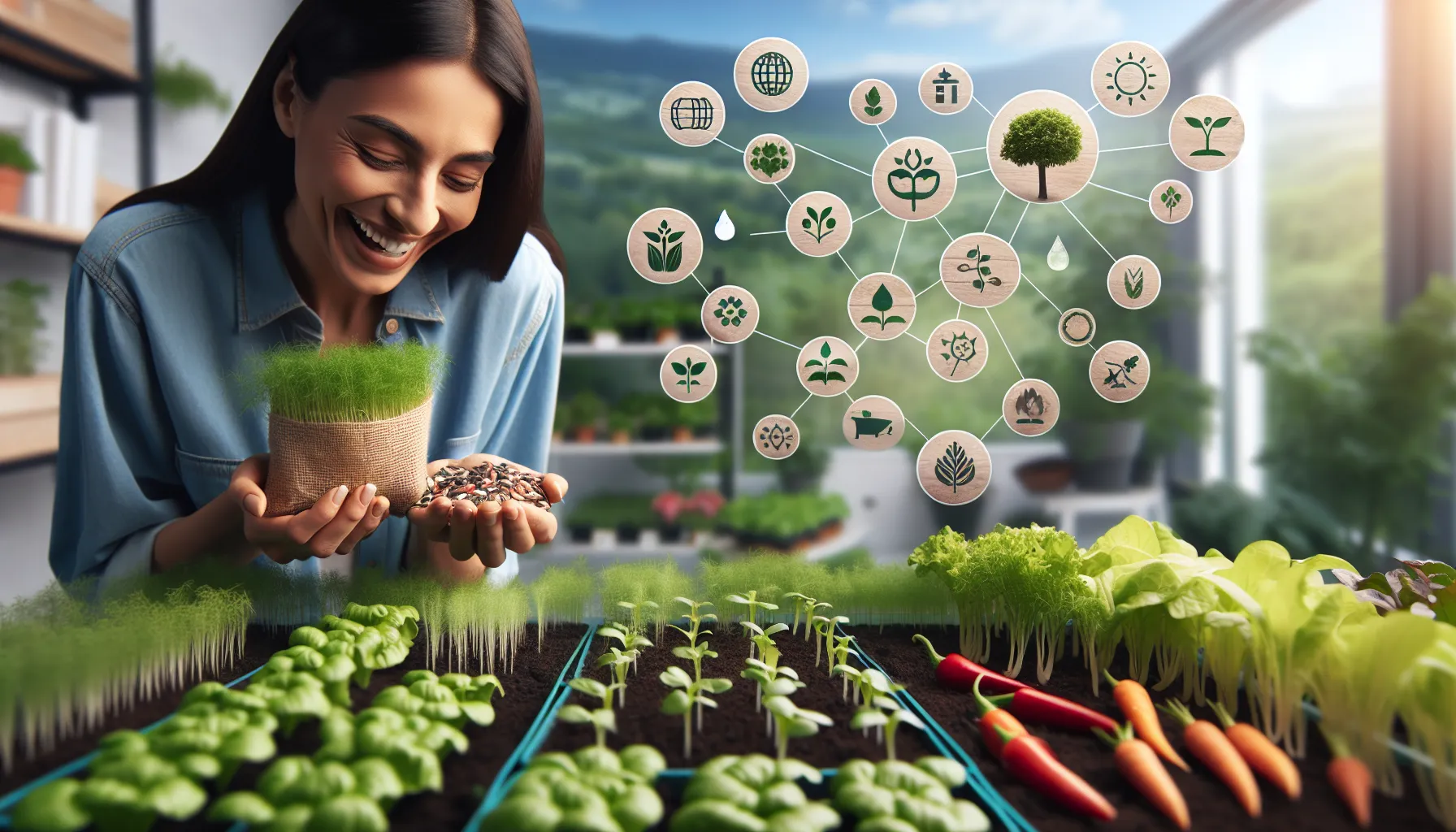
Picking the right vegetables for your garden is a fun but important step. You have to think about the weather where you live, what season it is, and what veggies you like to eat. Not all vegetables grow well everywhere, so choosing the right ones can help your garden be very successful!
Every vegetable has its own favorite weather. Some like it hot, and some like it cool. For example, tomatoes and peppers love the warm summer sun, while carrots and lettuce prefer cooler temperatures. Before you choose what to plant, look up what the weather is usually like in your area through the year. Also, think about what vegetables you and your family like to eat. There’s no point in growing something nobody wants to eat, right?
If you’re new to gardening, it’s a good idea to start with veggies that are easier to grow. This way, you won’t get discouraged if things don’t turn out perfect right away. Some good choices for beginners include lettuce, radishes, and green beans. They don’t need too much special care, so they’re a great way to learn about gardening.
When you’re ready to start your garden, you can choose to buy seeds or young plants (these are called “seedlings”). Seeds are cheaper and give you a wider variety to choose from. Planting seeds is also fun because you get to see them sprout and grow! However, it can take longer to get vegetables from seeds. If you’re impatient or want a bit of a head start, buying young plants might be better for you. They’re a bit more expensive, but you’ll have a garden full of veggies much faster.
Starting a vegetable garden is exciting, but it’s important to do it right. Knowing when to plant and understanding the process can help ensure your garden thrives. Let’s dive into the basics of getting your garden started.
Every plant has its perfect time to grow. This depends a lot on the weather, especially frost. Frost happens when it gets really cold, and it can kill young plants. So, knowing your area’s last frost date in spring and first frost date in fall helps you pick the best time to plant. Most seed packets or gardening apps tell you how many weeks before or after the last frost date you should plant. For example, if you’re planting tomatoes, they love warm weather and should be planted after the last frost when the soil is warm.
There are two ways to get your plants growing: sowing seeds directly into your garden or transplanting young plants (seedlings). Sowing seeds is what it sounds like—you plant them right where they will grow. This works great for veggies like carrots and beans that don’t like to be moved. Transplanting means you start the seeds indoors or buy young plants, and then move them into your garden. This method is good for slower-growing plants like tomatoes, which get a head start by growing indoors while it’s still too cold outside. Each method has its benefits, so think about what’s best for your garden and the plants you want to grow.
Water is crucial, but too much or too little can hurt your plants. A good rule is to water deeply but less often. This means giving enough water to soak the soil deeply, which encourages roots to grow down, making plants stronger. Aim for about an inch of water a week, but this can vary depending on how hot or windy it is. Early morning is the best time to water because it gives the plants time to drink up before the hot sun makes the water evaporate. Also, try to water the base of the plants to keep the leaves dry, which helps prevent diseases.
Root vegetables like carrots and radishes, leafy greens such as lettuce and spinach, and nightshades like tomatoes and bell peppers are great for beginners due to their hardiness and minimal care requirements.
Incorporate organic matter like compost or well-rotted manure into your garden soil. This will enhance its structure, fertility, and water-holding capacity. Regularly testing your soil and adjusting its pH based on specific crop needs is also beneficial.
Yes, crop rotation is important to prevent soil depletion and reduce the buildup of pests and diseases. Rotating crops with different nutritional needs and pest susceptibilities will help maintain soil health and balance.
Employ integrated pest management practices such as encouraging beneficial insects, using barriers or traps, and applying natural pesticides like neem oil or insecticidal soap only when necessary. Maintaining garden cleanliness and removing diseased plants promptly can also prevent pest infestations.
Harvest times vary depending on the vegetable. Leafy greens may be picked when they are of usable size, root vegetables when they are adequately sized, and fruits like tomatoes and cucumbers when they have reached their full color. It’s often best to harvest early in the morning for peak crispness and flavor.
Embarking on the journey of planting my first vegetable garden was a leap into the unknown, guided primarily by an array of blog posts, gardening books, and advice from seasoned gardening friends. My patch of land, modest yet eagerly awaiting its transformation, was my canvas for experimentation. Little did I know how much this project would teach me about patience, timing, and the fine balance of water.
The excitement of choosing which vegetables to grow was palpable. I had images of lush greenery, dotted with vibrant splashes of color from tomatoes, peppers, and eggplants. Yet, before any seed could kiss the soil, the crucial step of understanding the frost dates and growing seasons in my area took precedent. I was fixated on getting this right, knowing that timing was everything. A late frost could undo all the hard work in a single night, a thought that loomed over my eager intentions.
Opting to sow some seeds directly into the garden and transplant seedlings for others, I found myself reflecting on the stark differences between the two methods. Direct sowing felt like sending my children off to their first day of school, hopeful yet filled with concern. Would they emerge through the soil, strong and vigorous? In contrast, transplanting seedlings, which had started their life in the controlled environment of my sunroom, seemed less fraught with peril. These little plants already had a head start, and all they needed was careful transplanting to avoid shock. This process turned out to be a delicate dance of gentleness and precision.
The advice on watering was perhaps the most diverse and, at times, conflicting. ‘Water deeply but not too often,’ they said. Finding that sweet spot, ensuring my garden was hydrated but not waterlogged, became a daily ritual. I learned to observe the leaves, feel the soil, and eventually, understand the silent communication of my garden. Watering became more than just a task; it was a moment of connection.
As the season progressed, I watched in awe as my efforts were rewarded. The plants thrived, and I marveled at the resilience of nature and the impact of nurturing care. The joy of harvesting vegetables from a garden I created was unparalleled. Each meal was a celebration of the journey from seed to plate—a journey filled with learning, adjustments, and the simple pleasures of watching something grow.
In the end, my vegetable garden became more than just a source of produce; it was a testament to the importance of timing, the art of patience, and the delicate balance of water. It was a project that started with uncertainty but ended with a bounty of not only vegetables but also lessons learned and experiences gained.
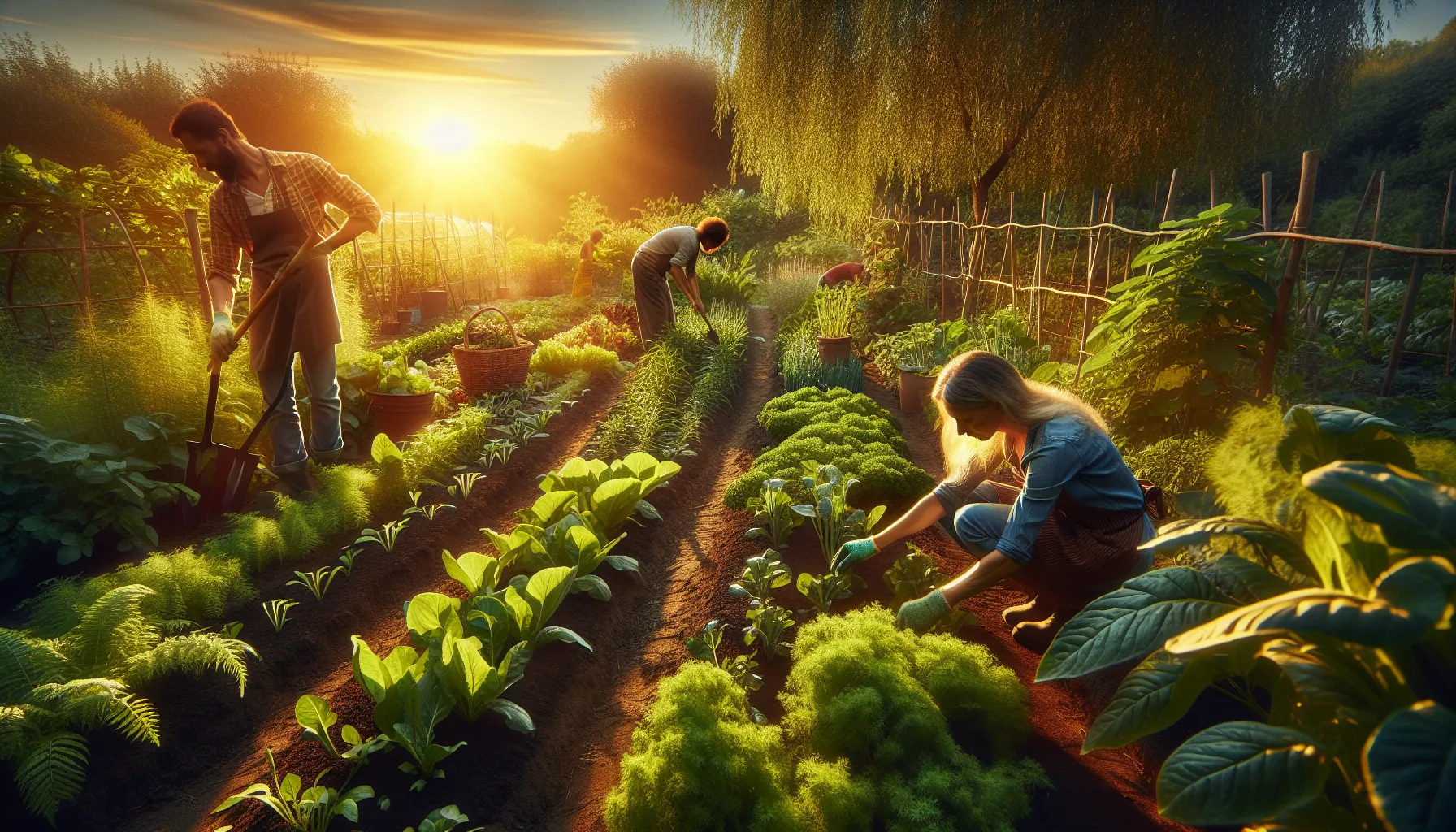
Making sure your vegetable garden grows well involves some important tasks. Taking care of your garden doesn’t have to be hard, but there are some things you should definitely do regularly. Let’s talk about how to keep your garden happy and healthy!
Weeding is all about removing plants you don’t want from your garden. These unwanted plants can take away water and nutrients from the veggies you’re trying to grow. Thinning is when you remove some plants to make room for others to grow bigger and stronger. For example, if you planted carrots really close together, you’d remove the weakest ones so the stronger ones have room to grow big. Pruning means cutting back parts of plants that are sick, damaged, or just growing too much. It helps your veggies get more air and light.
Keeping an eye on your garden is super important to stop bugs and diseases before they become big problems. You can deal with pests and diseases in ways that are safe for you and the environment. For example, planting certain flowers can keep bugs away, and using compost instead of chemical fertilizers can make your plants stronger and less likely to get sick. Remember, the sooner you spot a problem, the easier it is to take care of it.
Mulch is like a blanket for your soil. It’s a layer of material (like dead leaves, straw, or wood chips) that you spread over the soil around your plants. Mulching helps keep moisture in the soil, which means you don’t have to water as often. It also keeps weeds from growing and can make your garden look really neat. To mulch, just spread a layer of your chosen material around your plants. Make sure it’s not too thick or too thin – a layer about 2-3 inches deep works great.
After all your hard work in the garden, it’s time for the best part: harvesting. But how do you know when your veggies are ready to pick, and how do you do it right? Let’s dive in!
Different veggies tell us in different ways when they are ready to eat. For tomatoes, look for a rich color and a slightly soft feel. Lettuce leaves should be firm and crisp. Carrots should be poking out of the soil a bit, showing their size and color. Peppers get shiny and feel firmer when they are ready. It’s like each vegetable has its own way of saying, “I’m ready!”
Harvesting isn’t just about picking—it’s about picking right. For leafy greens like lettuce and spinach, use your fingers or scissors to cut leaves from the outside. This way, the plant keeps growing more for you to eat later! Root vegetables like carrots and beets need a gentle tug straight up, but sometimes they need a little loosening of the soil around them first. Tomatoes and peppers? Twist them off gently. For veggies growing on vines like cucumbers and squash, a small clipper is your friend to snip them off without hurting the plant.
Now you’ve got all these amazing veggies, but how do you keep them fresh? Well, most vegetables like a cool, dark place. Think about using your fridge for things like lettuce and peppers, but not all veggies like the cold—tomatoes and potatoes prefer to stay out. Want to keep enjoying your harvest for months? Try freezing, canning, or drying some of your veggies. This way, you can taste the success of your garden even in winter!
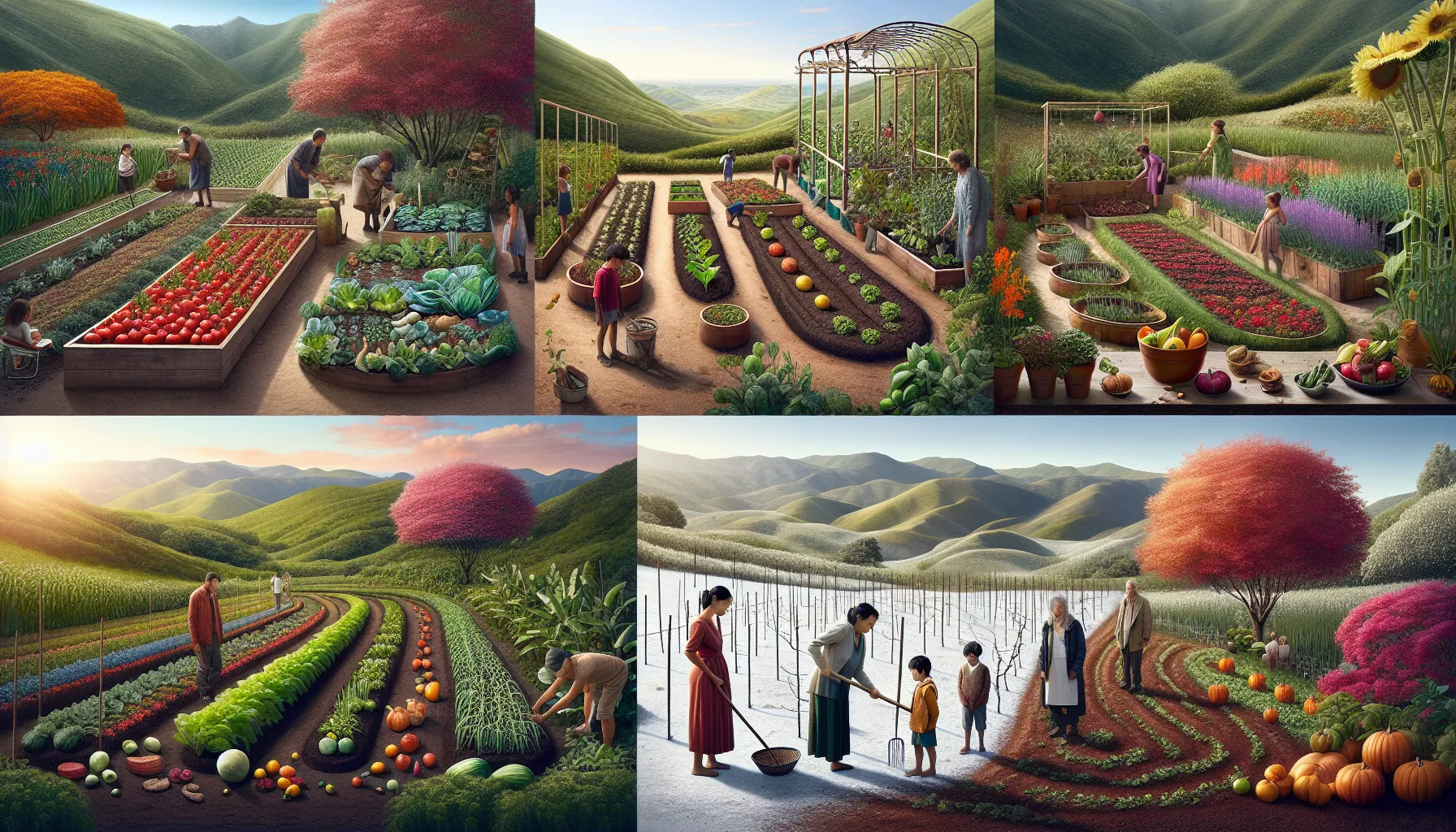
As the seasons change, so should the care for your vegetable garden. Just like we switch our clothes for the weather, your garden needs different things in spring, summer, fall, and winter. Taking the right steps at the right time can help your garden stay healthy and productive through the year.
When a new season is on the way, it’s time to get your garden ready. In spring, clear out dead plants and dig the soil to make it nice and loose for new plants. Summer might need you to add more water and maybe some shade to protect plants from the hot sun. Come fall, start removing old plants that are done for the year, and in winter, add mulch or straw to keep the soil warm and cozy until spring. Each season has its own to-do list!
Even when it’s too cold or too hot for your regular vegetables, you can still help your garden. One great idea is to plant cover crops, like clover or rye, in the off-season. These plants do a fantastic job at keeping your soil from getting too hard or losing nutrients. When you’re ready to plant vegetables again, these cover crops get mixed into the soil, making it richer and better for your new plants.
Another important task for the off-season is restoring your soil. This might mean adding compost to feed your soil or checking the pH level to make sure it’s just right. Healthy soil means healthy plants, so taking the time to care for your soil when you’re not growing veggies is super important.
Starting your vegetable garden might seem like a big task, but remember, every gardener was once a beginner. Don’t be afraid to start small and learn as you go. Even the smallest patch can produce a surprising amount of tasty veggies. And the more you garden, the better you’ll get. Gardening is a journey of learning by doing, and every season teaches you something new.
Besides the fun of getting your hands dirty, vegetable gardening brings so many rewards. Imagine the joy of biting into a fresh tomato, right from your garden, or the taste of crisp lettuce that you grew yourself. These aren’t just delicious; they’re your own creations. Gardening is also great for your health—not just because you’re growing nutritious food but because it gets you out in the fresh air and sunshine, moving and stretching. Plus, think of the money you’ll save by growing some of your own food. Every carrot, potato, or bean you harvest is one less you have to buy from the store. So, what are you waiting for? Your garden adventure is just waiting to begin!

